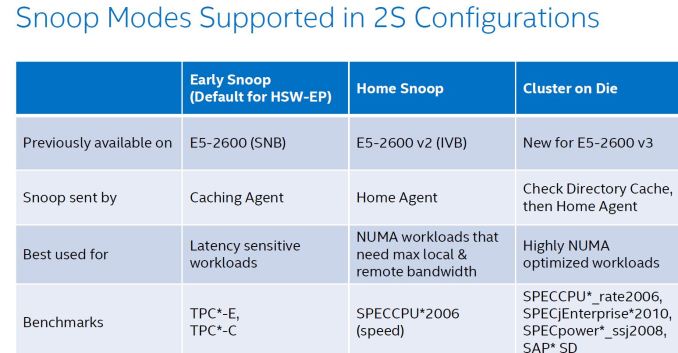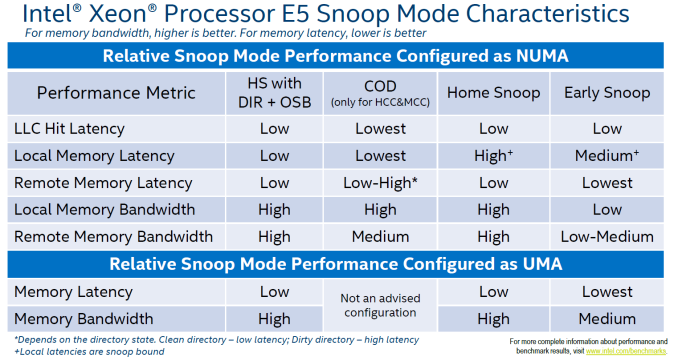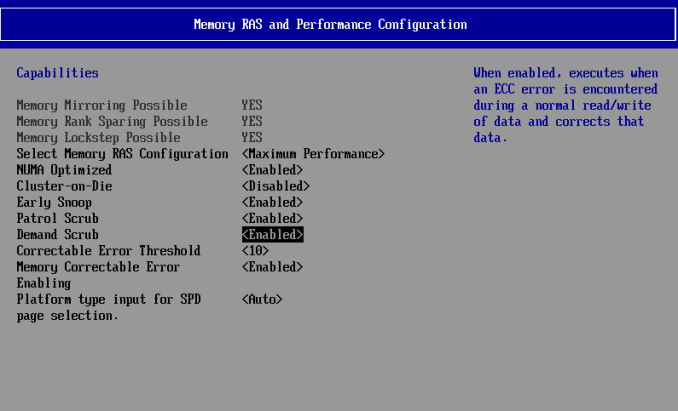The Intel Xeon E5 v4 Review: Testing Broadwell-EP With Demanding Server Workloads
by Johan De Gelas on March 31, 2016 12:30 PM EST- Posted in
- CPUs
- Intel
- Xeon
- Enterprise
- Enterprise CPUs
- Broadwell
Broadwell-EP: A 10,000 Foot View
What are the building blocks of a 22-core Xeon? The short answer: 24 cores, 2.5 MB L3-cache per core, 2 rings connected by 2 bridges (s-boxes) and several PCIe/QPI/home "agents".
The fact that only 22 of those 24 cores are activated in the top Xeon E5 SKU is purely a product differentiation decision. The 18 core Xeon E5 v3 used exactly the same die as the Xeon E7, and this has not changed in the new "Broadwell" generation.
The largest die (+/- 454 mm²), highest core (HCC) count SKUs still work with a two ring configuration connected by two bridges. The rings move data in opposite directions (clockwise/counter-clockwise) in order to reduce latency by allowing data to take the shortest path to the destination. The blue points indicate where data can jump onto the ring buses. Physical addresses are evenly distributed over the different cache slices (each 2.5 MB) to make sure that L3-cache accesses are also distributed, as a "hotspot" on one L3-cache slice would lower performance significantly. The L3-cache latency is rather variable: if the core is lucky enough to find the data in its own cache slice, only one extra cycle is needed (on top of the normal L1-L2-L3 latency). Getting a cacheline of another slice can cost up to 12 cycles, with an average cost of 6 cycles..
Meanwhile rings and other entities of the uncore work on a separate voltage plane and frequency. Power can be dynamically allocated to these entities, although the uncore parts are limited to 3 GHz.
Just like Haswell-EP, the Broadwell-EP Xeon E5 has three different die configurations. The second configuration supports 12 to 15 cores and is a smaller version (306mm²) of the third die configuration that we described above. These dies still have two memory controllers.
Otherwise the smallest 10 core die uses only one dual ring, two columns of cores, and only one memory controller. However, the memory controller drives 4 channels instead of 2, so there is a very small bandwidth penalty (5-10%) compared to the larger dies (HCC+MCC) with two memory controllers. The smaller die has a smaller L3-cache of course (25 MB max.). As the L3-cache gets smaller, latency is also a bit lower.
Cache Coherency
As the core count goes up, it gets increasingly complex to keep cache coherency. Intel uses the MESIF (Modified, Exclusive, shared, Invalid and Forward) protocol for cache coherency. The Home Agents inside the memory controller and the caching agents inside the L3-cache slice implement the cache coherency. To maintain consistency, a snoop mechanism is necessary. There are now no less than 4 different snoop methods.
The first, Early Snoop, was available starting with Sandy Bridge-EP models. With early snoop, caching agents broadcast snoop requests in the event of an L3-cache miss. Early snoop mode offers low latency, but it generates massive broadcasting traffic. As a result, it is not a good match for high core count dies running bandwidth intensive applications.
The second mode, Home Snoop, was introduced with Ivy Bridge. Cache line requests are no longer broadcasted but forwarded to the home agent in the home node. This adds a bit of latency, but significantly reduces the amount of cache coherency traffic.
Haswell-EP added a third mode, Cluster on Die (CoD). Each home agent has 14 KB directory cache. This directory cache keeps track of the contested cache lines to lower cache-to-cache transfer latencies. In the event of a request, it is checked first, and the directory cache returns a hit, snoops are only sent to indicated (by the directory cache) agents.
On Broadwell-EP, the dice are indeed split along the rings: all cores on one ring are one NUMA node, all other cores on the other ring make the second NUMA node. On Haswell-EP, the split was weirder, with one core of the second ring being a member of the first cluster. On top of that, CoD splits the processor in two NUMA nodes, more or less one node per ring.
The fourth mode, introduced with Broadwell EP, is the "home snoop" method, but improved with the use of the directory cache and yet another refinement called opportunistic snoop broadcast. This mode already starts snoops to the remote socket early and does the read of the memory directory in parallel instead of waiting for the latter to be done. This is the default snoop method on Broadwell EP.
This opportunistic snooping lowers the latency to remote memory.
These snoop modes can be set in the BIOS as you can see above.















112 Comments
View All Comments
JohanAnandtech - Saturday, April 2, 2016 - link
Ok, thanks, time to sleep a little longer. I have fixed the error.xrror - Friday, April 1, 2016 - link
It's depressing to see the mobile-first design philosophy really gutting into the last bastion of x86 performance.I mean I get it - a 22 (20) core xeon wouldn't even exist without the aggressive power management tech needed to keep it from melting or needing exotic cooling. But it's still depressing to see ALL of the arch improvements immediately negated with lowered clock speeds, or worse "turbo speeds" you will never actually see once the machine is running production loads.
The engineering behind these big core count chips though is always very impressive. Also did Intel ever say how they "fixed" TSX?
FunBunny2 - Friday, April 1, 2016 - link
"It's depressing to see the mobile-first design philosophy really gutting into the last bastion of x86 performance."welcome to the world of laissez faire capitalism: do what makes the most money today, irregardless of future consequences. used to be, Intel could rely on M$ making the next versions of Windoze and Office impossible to run on existing Pentiums, thus driving sales of the next Pentium (a whole machine, at that). these days it's up to gamers and data centres. not taking any bets on which turns out to be in the driver's seat.
xrror - Friday, April 1, 2016 - link
Well, considering that "computer gaming" has degraded to whatever the kids are running on their smartphones, or the parent's tablet I'm not hopeful for any new resurgence in demand for high performance PC's in the mass market.So the future consequences for Intel prioritizing power efficiency over performance, or possibly developing a separate fabrication tech for performance is... likely not very much. So there really is no "future consequence" for Intel. Sure they could go out and actually try and make a 10Ghz 9nm part possible, but nobody in 2020 would buy it because... it probably would go into whatever iDevice they care about. And HPC market I dunno. Maybe if it datamines marketing data faster or can microtrade on the stock market faster or something. meh.
The general public really doesn't care about performance anymore (honestly, they may never have), only how portable it is and if a device is good enough to run their stuff on the go.
The high end market like these multi-core xeons though, is strange because you'd think this is where Intel would go all in, but I guess when your only competitors are IBM Power and (currently non-competitive) AMD I dunno...
I mean it's sad, even Intel has to beg to justify it's R&D expenses to shareholders - which is stupid because Intel's R&D is one of it's biggest strengths. But such as it is. Apr 1 rant over ;)
abufrejoval - Friday, April 1, 2016 - link
Johan, you keep bemoaning the fact that lack of competition seems to stop "real progress" and I wonder where you expect that progress to happen.More specifically you seem to desire more GHz and I can understand that desire, which may originate from that crazy 40MHz to 4GHz rush we all experienced somewhere in the decade starting in the mid nineties.
I understand the emotion, but I wonder how it fits the scientific mind I see everywhere else in your work, because 8, 16 or 32 GHz is simply not going to happen, competition or not.
Sure 8GHz are possible, you can even purchase 5GHz off the shelves. But it simply doesn't deliver in terms of Oomp/$. And Web Scale is all about value/€ and the main driver of server evolution today.
We'll still see radical speedups where it counts, but it will have to be via special purpose function blocks either on SoCs, or by adding a couple of extra instructions or by doing something as radical as Micron's Automata Processor.
But general purpose von Neumann has hit the Gigahertz wall years ago and nothing can change that except a different model of compute.
I liked the reference to Andreas Stiller, but I'm not sure everybody here has a subscription to c't like I do since the early 1990's. There could also be the tiny issue that not everyone outside Belgium is quadrilingual.
Make no mistake: I love your work! It's a pleasure to read for form, style and the content!
The Von Matrices - Saturday, April 2, 2016 - link
Any indication of the QPI speed of these chips? Did Intel increase it from the 9.6 GT/s in Haswell-EP?Ian Cutress - Saturday, April 2, 2016 - link
Most of the high end are 9.6 GT/s. https://twitter.com/IanCutress/status/715582714099...watersb - Saturday, April 2, 2016 - link
Johan, this is fantastic work. Thanks very much.Any way to address RAS features?
isrv - Saturday, April 2, 2016 - link
well, i'm completely dissapointed.web servers wants higher clock speed.
single-thread load (like PHP) become even slower on those E5v4 due to drop in GHz's.
still, the best CPU's for that is E3-1290v2, E3-1281v3 (and 1286v3), E3-1280v5, E5-1630v3, E5-1620v2 and the only one 6-core E5-1660v2
all those are 3.7Ghz (pointless to look at turbo speed since we're under constant 24/7 load).
i was hoping to at least one 3.8GHz or even higher.
so no changes here, E5-1660v2 is still the fastest web-server CPU.
or E5-1630v3 by sacrificing 2 cores for a bit faster memory.
patrickjp93 - Sunday, April 3, 2016 - link
For those 4-8 core chips, the turbo boost is maintainable for 24/7 workloads if your cooling is sufficient. You seem to know far less about this environment than you let on. And who the hell still uses single-threaded PHP? And you're not taking into account better caching algorithms and other architectural improvements that make the 200MHz slower V4 run faster than your V2.